The State of Health & Safety In HR Report
Read about the state of health and safety in HR and how you can help your company become a leader in workplace safety
by Amanda Cross - September 22nd, 2022
At the beginning of the pandemic in 2020, HR professionals worldwide were given a monumental task: to keep people safe. Amid the uncertainty of the pandemic, PPE shortages, and new work arrangements, HR had to keep it together to ensure that companies ran smoothly.
A recent AlertMedia survey found that:
97% of employees say that safety is important when considering where they work
“Employer generally cares about employee safety” was the #2 motivation for why employees stay with employers long term
89% of employees think a safe workplace is more important than ever.
Companies need to understand where HR fits into the safety equation and what can be done to prioritize workplace safety. To understand HR’s role in employee health and safety, we surveyed 1,000 US-based HR professionals.
Our survey spanned various employee sizes, industries, and work locations, unveiling interesting insights on:
Who's involved in the employee health and safety process?
Safety perceptions across the company as seen by HR.
Top safety concerns and what HR has experienced at their company.
Strategies companies are using to combat health and safety issues at work.
Let’s dive into how HR professionals, specifically, feel about the state of workplace health and safety:
HR's Involvement In Employee Health And Safety
First, it's crucial to establish who is involved in these health and safety decisions. 89% of the HR professionals that we surveyed were involved in health and safety in some way. For 42% of our respondents, HR was primarily responsible for health and safety.
Companies with fewer than ten employees relied most heavily on their HR departments to handle these initiatives, as HR was solely responsible for managing health and safety at 56% of those companies. A company's industry had a significant correlation with HR involvement, too.
To continue reading, please enter your work email
For example, HR is often exclusively accountable for health and safety at retail/customer service (53%) and software/IT (50%) companies.
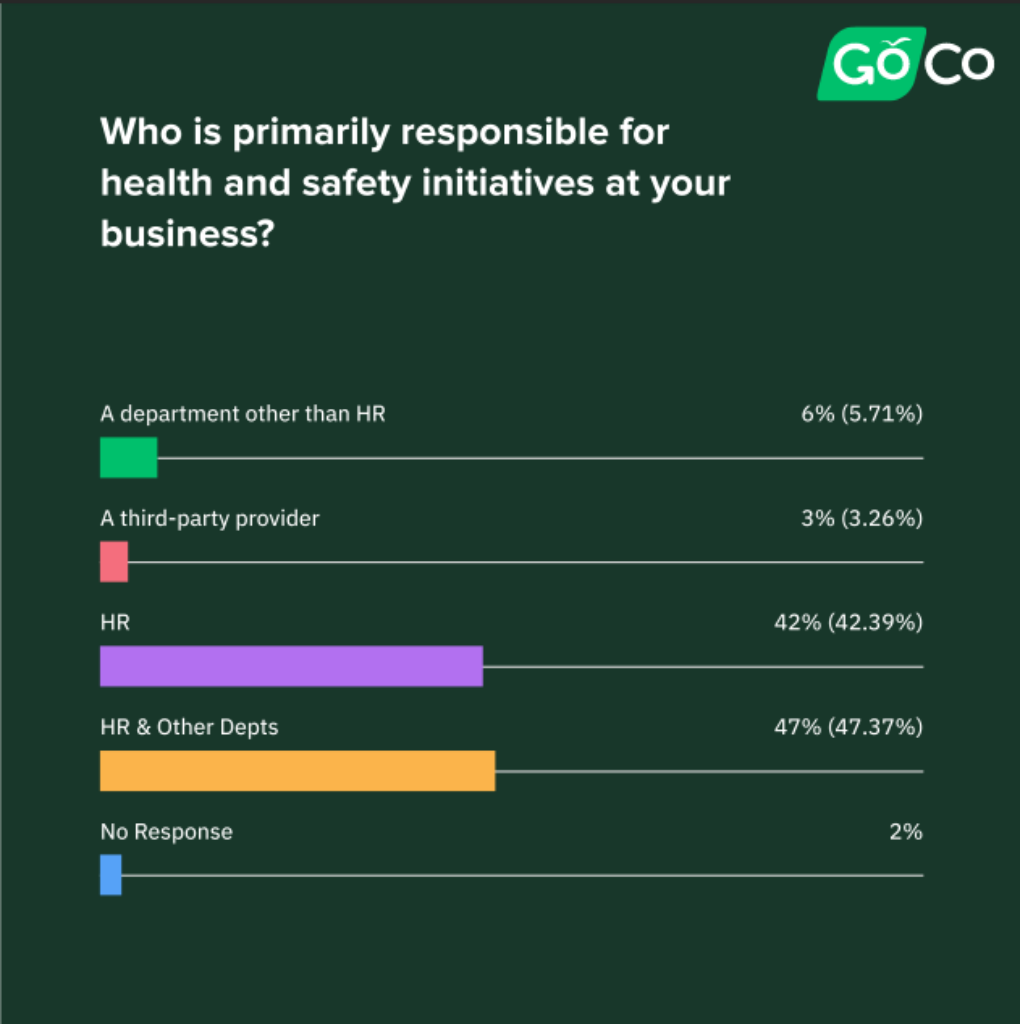
While HR is heavily involved in safety at work, most professionals feel comfortable with their level of involvement. Many HR professionals would like to get more involved in health and safety initiatives.
Overall, 64% of HR professionals enjoy their current level of involvement in health and safety. Furthermore, 24% of HR professionals would like to extend their involvement in the health and safety process at work. Around 37% of HR professionals in the retail/customer service space shared they'd like to be more involved in the health and safety process, a stronger desire for involvement than in any other industry.
Organizations and HR professionals need to work to determine what level of involvement HR should have in these decisions. If HR leaders have the desire and the capacity to be more involved, their companies should welcome it.
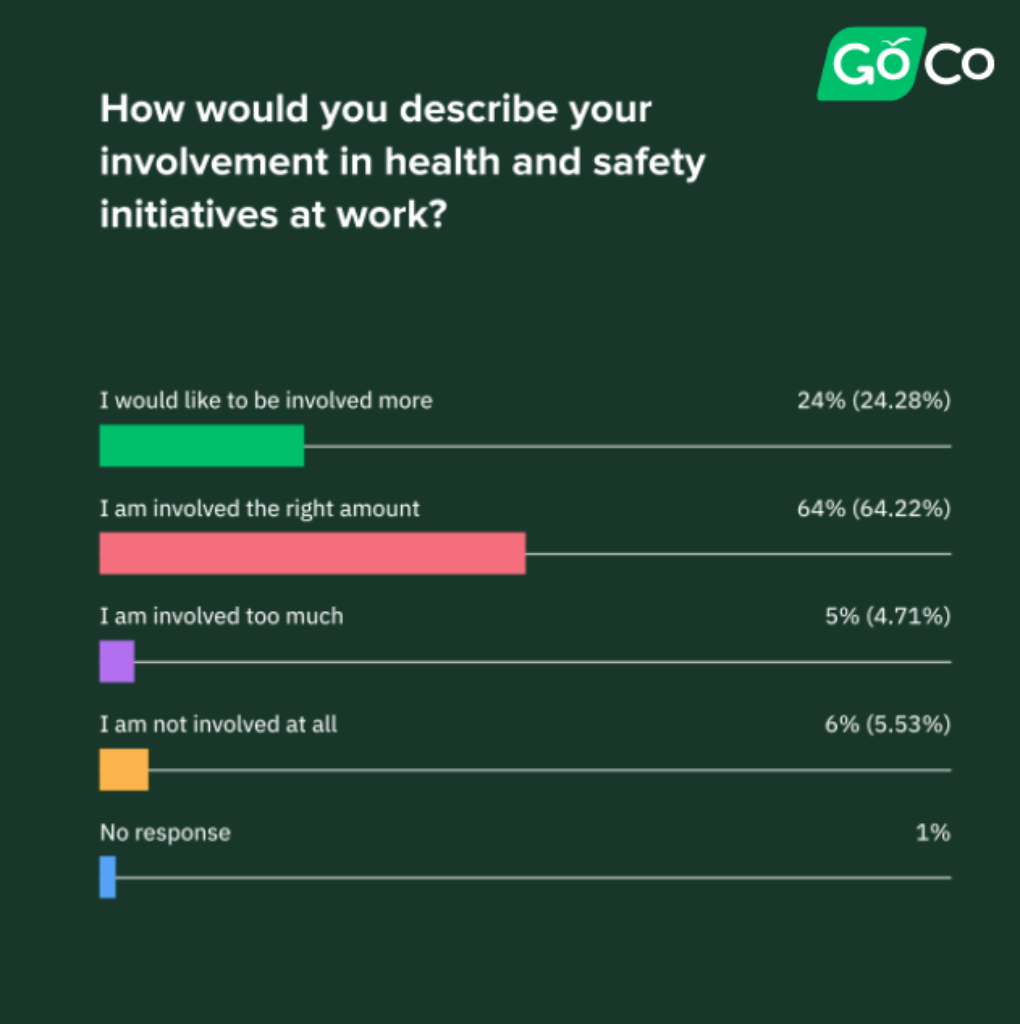
Does Safety Matter To Employees And Leadership?
The pandemic has profoundly impacted how employees understand health and safety. As we consider what work and life will look like post- pandemic, it's evident that employees expect different workplace health and safety standards. How much did the pandemic impact employees? Does company leadership's prioritization of workplace health and safety align with the needs of the employees? We want to examine these themes below:
Employee Expectations
Our survey revealed a desire for increased safety standards amongst employees. 77% of respondents believe that employees expect more emphasis on workplace safety standards since the beginning of the pandemic.
The desire for improved safety increases based on a few variables, such as employee size, industry, and workplace location.
83% of HR professionals who work at companies with 501-1000 employees believe their teams demand safer workplaces. As companies expand, they often deal with growing pains. Keeping up with the needs of employees can be challenging as your team grows. Since many of these employees want increased safety standards, companies of this size need to listen.
84% of HRs in the healthcare industry believe that employees desire increased safety standards to take care of their patients, their families, and themselves.
Leaders in the healthcare industry must listen and ensure safety is a top priority now and post-pandemic. Other industries like retail, education, and government have also seen this expectation increase, which is no surprise as these industries are full of frontline workers who saw the impacts of the pandemic up close.
Lastly, 81% of HRs in hybrid workplaces are seeing an increase in employee desire for increased safety standards. Hybrid workers face an interesting experience when choosing to go into the office. At home, they have more control over health and safety, making safety at the office more necessary.

Leadership's Focus
While employee desires are important, leadership needs to listen to their concerns and prioritize safety. Ultimately, leadership is accountable for how much money, time, and effort is given to health and safety. If leaders don’t offer the funds and resources to prioritize safety, it doesn’t happen.
93% of the HR professionals we surveyed shared that workplace health and safety were important to their leadership teams. However, there is a disconnect because only 39% of all respondents feel health and safety are top priorities for their leaders.
The companies where health and safety are a top priority make sense. When these industries fail to prioritize health and safety, employee and consumer health is at risk. Programs like Fatality Assessment and Control Evaluation (FACE) address how dangerous some jobs can be for workers. The Food and Drug Administration (FDA) investigates the impact lackluster products have on consumers. Company leadership must understand the implications of poor safety practices. It's essential to match employee and leadership expectations on this issue.
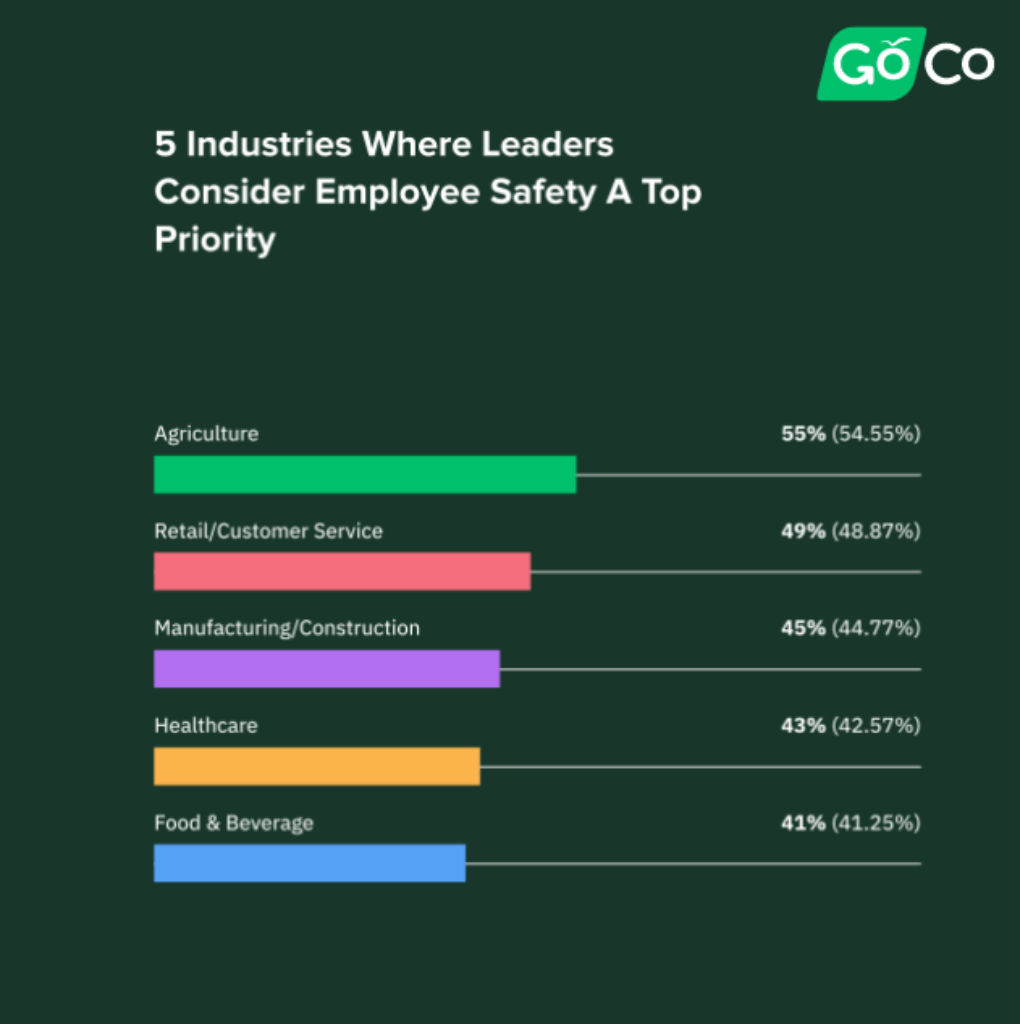
Top Safety Concerns And Experiences
Expectations don’t always meet reality. HR professionals are often the employees responsible for handling complex safety issues that could impact the company and team members. We wanted to examine:
What are the top safety concerns amongst HR professionals?
What safety issues are HR professionals experiencing?
How prepared do HR professionals feel to handle top HR safety experiences?
What Are HR’s Top Safety Concerns?
Topping the list of primary safety concerns are employee health/illness, on-the-job injuries, and emotional/psychological injuries.
It's not surprising that employee health is at the top of HR professionals' list of safety concerns. COVID has impacted nearly every facet of employees' lives over the past 2+ years. The silver lining is that many HR teams have used the pandemic to develop stronger safety programs, improve employee communication, and ensure employees' health and well-being are being prioritized at all levels of the organization, which will have a positive impact over the long term.
As we look at the difference between concerns and experiences, one workplace safety issue stands out, and that's severe weather and natural disasters. While only 13% of HR professionals had concerns, 17% of the professionals we surveyed experienced them in the last year. As the climate continues to be an issue that garners international attention, HR professionals may need to consider how severe and unpredictable weather might impact their employees.
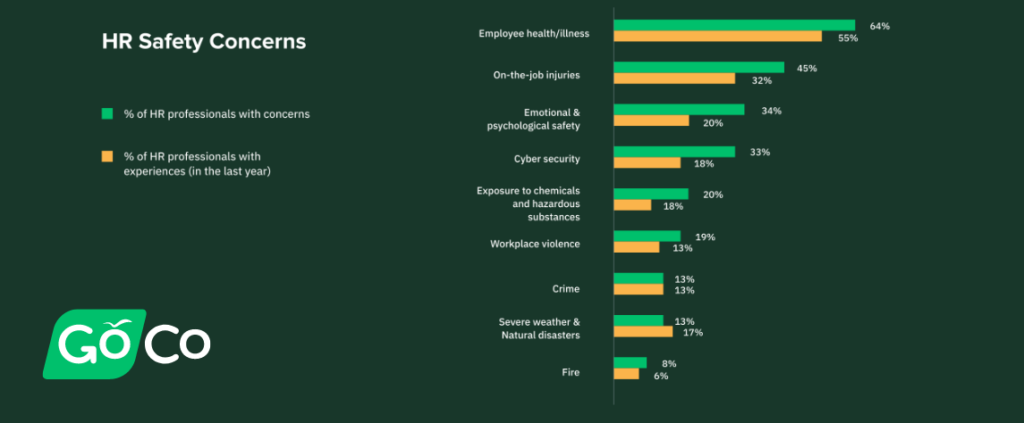
How Prepared Is HR To Take On Top Health And Safety Issues?
It's important to understand HR preparedness. Since HR is so involved in workplace health and safety, their preparedness greatly impacts the company as a whole. Across the board, HR professionals do feel prepared, but the survey shows some notable gaps in their expertise:
Even though emotional & psychological safety, cyber security, and severe weather are issues that many HR professionals deal with, 20-25% of HR pros are not sure if they're prepared or feel completely unprepared to deal with these issues.
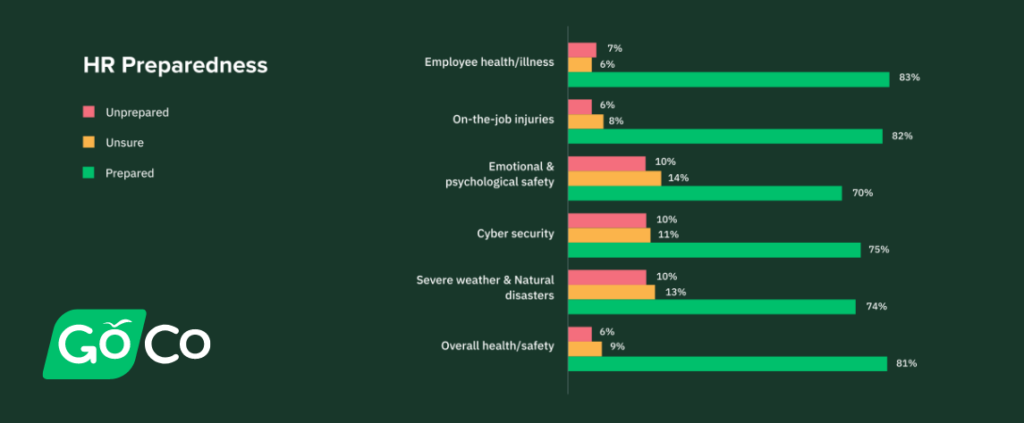
A Spotlight On Psychological Safety & Workplace Violence
Employees’ emotional and physical safety will be a top challenge for employers moving forward. Only 70% of HRs felt prepared to handle these issues, the lowest percentage of all issues. Emotional well-being has become a hot topic in the HR community recently. It's essential to have a conversation about what can be done to prepare HR professionals for these experiences.
As we've seen, 34% of HR professionals worry about emotional & psychological safety, while 20% dealt with this issue in the last year. Almost 1 in 4 of the HR professionals we surveyed were unprepared or unsure about how prepared they were to handle emotional well-being at work.
Workplace location impacts concerns for emotional and psychological safety. Hybrid HR teams seem to be the most concerned.
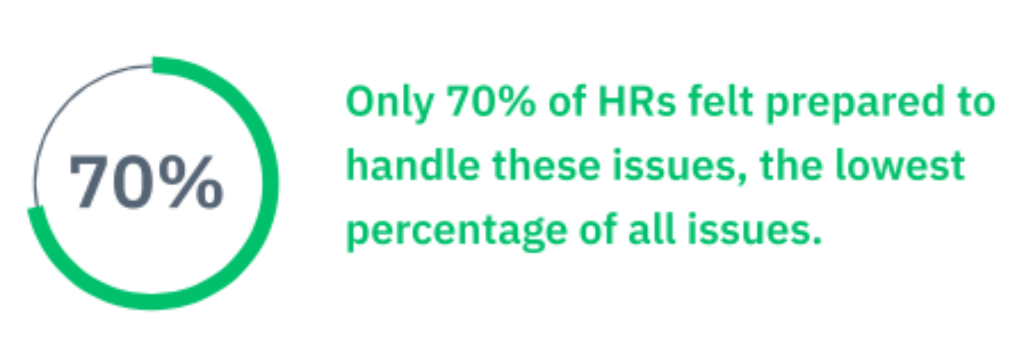
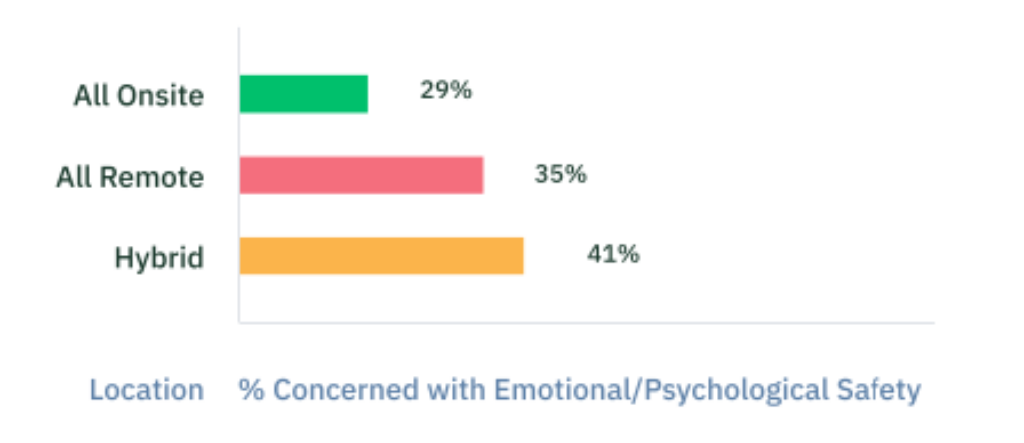
Hybrid work arrangements are still new for many companies, so navigating emotional and psychological safety might be challenging since HR needs to navigate safety both online and in person.
Specific industries are more concerned with emotional and psychological safety. While on average, 34% of survey participants were concerned with emotional and psychological safety, education (54%), nonprofits (52%), and software/IT (43%) were the most concerned. While 20% of HR professionals dealt with this issue in the last year, psychological safety hit specific industries harder:
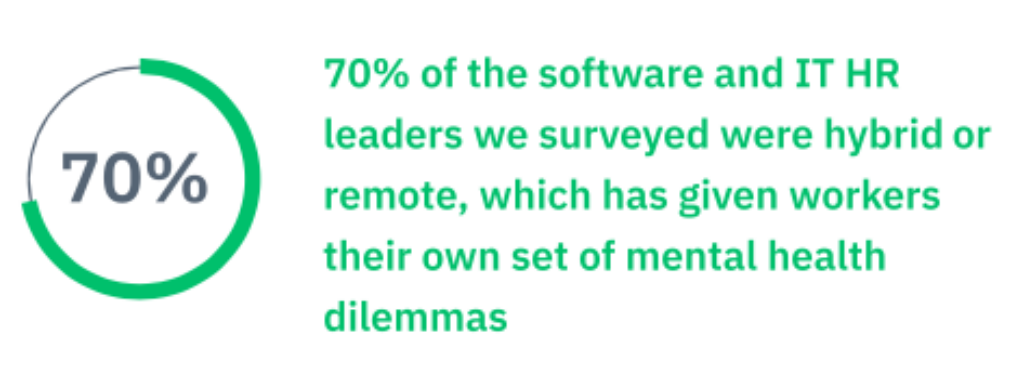

The pandemic has especially hit education and healthcare professionals. Healthcare workers had to care for thousands of patients while quarantined from their families, while educators had to deal with rapid changes to their work experience overnight. Furthermore, 70% of the software and IT HR leaders we surveyed were hybrid or remote, which has given workers their own set of mental health dilemmas. It makes sense that these industries are struggling to cope and experiencing these issues at higher rates.
The topic of workplace violence can’t be ignored. 19% of the HR professionals we surveyed worried about general workplace violence, while 13% experienced it in some form in the last year. Onsite HR is most concerned with workplace violence, with 20% noting their concern, with 14% experiencing it in the past year.
While retail/customer service (25%), business and finance (23%), and education (22%) felt the most concern about workplace violence, experiences were slightly different.
Professionals working in education feel the least prepared for workplace violence. Overall, 71% of HR workers think they are at least somewhat prepared to respond to violence in the workplace. Only 54% of HR pros in education feel prepared.
Workplace safety is of utmost importance. Concerns and experiences with workplace violence are worrying, especially for education and government. Unfortunately, both industries have dealt with active shooters/gun violence. It's necessary to take these concerns seriously and ensure that workplaces are as prepared as they can be.
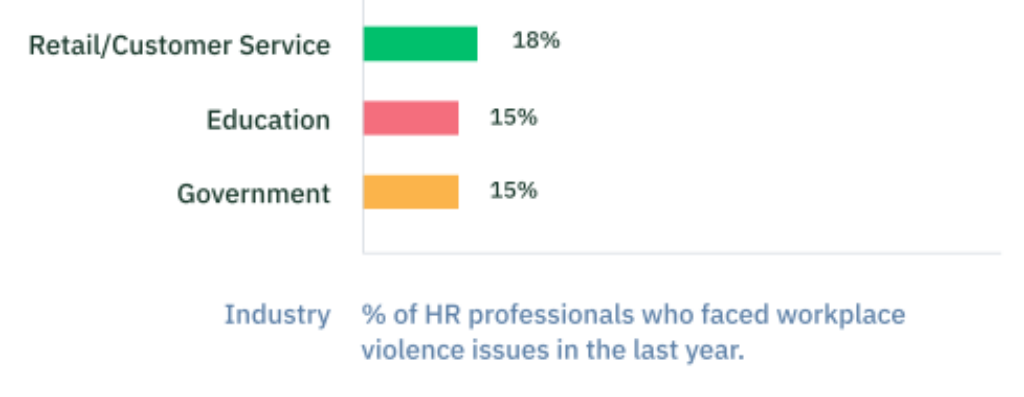
What Companies Can Do To Improve Employee Health And Safety
While many HR professionals feel like they have a handle on health and safety, there’s always room for improvement. It's also important to note that HR and employee perceptions are different.
As an emergency communication software provider, we hear constantly from organizations that there is a disconnect between what employers believe they are doing to keep employees safe and what workers perceive the organization is doing to protect them,” shares Woolford. “While there are many aspects to this, building trust and alignment between upper management and the entire workforce starts with communication. Employers need to both communicate a plan for how they will keep workers safe and informed and ensure employees’ feedback and concerns are factored into safety programs.
Let's go over some of the many ways your team can enhance communication to improve employee health and safety.

Cover Safety During Employee Onboarding And Training
Employee onboarding is an essential experience for new hires. Your team’s attention will be at its highest during this experience, and they are taking in a lot of information. 67% of the HR professionals we surveyed covered safety issues during the training process. Government (75%), manufacturing/construction (72%), and real estate (71%) companies utilize safety training during the onboarding process more than the other industries we surveyed.
Implement a health and safety policy
Having employees sign off on a policy during the onboarding and training is a great way to cover safety. Of course, you should include a copy of your policy in your handbook, but it's even more critical to ensure employees read and give an affirmative sign that they've read and understood the safety policy.
The goal of a healthy workplace policy is not only to protect employees from harm but also to help them feel safe and comfortable at work. By providing a positive environment where everyone feels supported, you can ensure that your company's health & safety record continues to improve year after year.
Here are some of the items you can include in your company’s healthy workplace policy:
Physical activity guideline
Food & allergy information
Stress management measures
First aid and CPR policies
Emergency protocols
Fire safety guidelines
Provide Safety Labeling And Signage
Another way that companies are improving health and safety is through signage and labeling. For example, you might have a sign that employee must wash their hands in the bathroom or hazardous materials warning labels where you keep chemicals. 46% of the HR professionals we surveyed utilized this method. As expected, this is more prevalent in the manufacturing/construction (58%), food/beverage (55%), and retail/ customer service (50%) industries.
Disseminate educational resources that give employees health advice and information. In your office space or digital newsletter, include tips such as better ways to improve posture at work, healthy diet reminders, and other advice focused on improving staff's wellbeing and happiness.
Collect Employee Feedback And Requests Related To Safety
44% of HRs surveyed said that their companies collect employee feedback and requests for health and safety initiatives. Your employees may have different health and safety perceptions than executives or HR managers. Collecting employee feedback gives you a chance to see what those perceptions and ideas are so you can correct any gaps between you and your employees. Industries like software/IT (59%), real estate (57%), and agriculture (54%) utilize this safety strategy.
HR professionals and company leaders must make it easy to report incidents, listen to the reports, and act on them.
Create a specific Slack channel where employees can freely express their concerns about workplace safety. Encourage them to share their experiences and proactively report instances that can potentially cause accidents and harm in the workplace. Doing so helps prevent further damage among employees and ensures that the management addresses the negative situations before they occur.
Track and Report on Safety Metrics
An essential part of workplace safety involves tracking and reporting safety metrics. HR professionals should be meticulous about keeping up with incidents and investigating thoroughly. Without these measures, the workplace cannot actively improve. 41% of the HR professionals we surveyed tracked and reported safety measures. This strategy was more common in manufacturing/construction (50%), healthcare (45%), and retail/customer service (44%).
Maintain a detailed incident log
One of the easiest ways to track and report safety is by starting a detailed incident log. An incident log allows you to keep up with what happens, spot trends, and correct problematic behavior.
Make sure your team takes regular breaks
Do you keep a clean record of employee breaks at work? It's often easy to skip breaks because managers aren’t always great at making employees take time throughout their shifts. Companies may even incentivize employees to work through breaks or create production schedules that make breaks complicated.
Workers are most at risk when they feel tired or sluggish in the workplace, particularly if they're overworked, stressed out, or under-slept. When workers are less alert, and therefore less attuned to their surroundings, they're more likely to put themselves in harm's way. It's of utmost importance that your team takes breaks regularly, so as to ensure that they return to the workplace feeling fresh and energized. This keeps them aware of potential pitfalls, enabling them to work safely and sensibly.
Keep up with employee schedules to ensure breaks are taken promptly. If you are on-site, make rounds to ensure employees are getting away from their workstations. If you are online or hybrid, remind employees to step away from their computers and get outside occasionally. Track employee breaks by making sure that employees are clocking in and out for general and lunch/dinner breaks.
Minimize employee stress in the workplace
Workplace stress is also an important factor to measure. If left unchecked, stress can lead to employee burnout and overwork.
Stress can cause employees to have difficulty concentrating, which can increase the risk of accidents in the workplace as well as reduce productivity. “Making sure that your employees take the time off that they need, have a good work-life balance, and aren’t overworked will go a long way towards reducing stress, preventing burnout, and improving workplace health and safety. Having better concentration will also help employees to remember any safety training provided to them.
Recognize And Reward Safe Workplace Behavior
Safety isn't the most engaging workplace topic. It can often be challenging to help employees understand the value of safety, but recognizing excellent behavior can help. 37% of the HR professionals we surveyed shared they used recognition and rewards to encourage safe workplace behavior. This practice was most common in software/IT (49%), retail/customer service (46%), and agriculture (45%).
Make health and safety part of employee engagement
Another way to recognize safe workplace behavior is to integrate it into your employee engagement experience. If you handle it correctly, health and safety can be fun and enjoyable.
Include health and safety activities in your employee engagement program. For instance, I incorporate virtual exercises into our employee engagement activities to help my remote employees stay active and remind them to take good care of themselves even if we’re on a remote or stay-at-home work setup. A 15-minute video-assisted stretching and aerobic exercise can help you stay in shape. We also share tips, such as diet plans and hobbies, during our team lunches and small talks.
Which Industries Are Doing The Most For Employee Health And Safety?
To determine if HR teams take safety seriously, we asked HR professionals what steps they took to improve company safety. They could pick all the strategies that applied to their company's situation.
Employee training
Hiring third-party service providers or safety experts
Recognizing and rewarding safe behavior
Safety labeling and signage
Collecting employee feedback and requests
Tracking and reporting safety metrics
Providing onsite vaccinations
While some steps like employee training stood out, many teams scored low in other areas, as the averages across each industry show. For example, nonprofits ranked last in the actions taken to improve health and safety, while manufacturing/construction scored the highest.
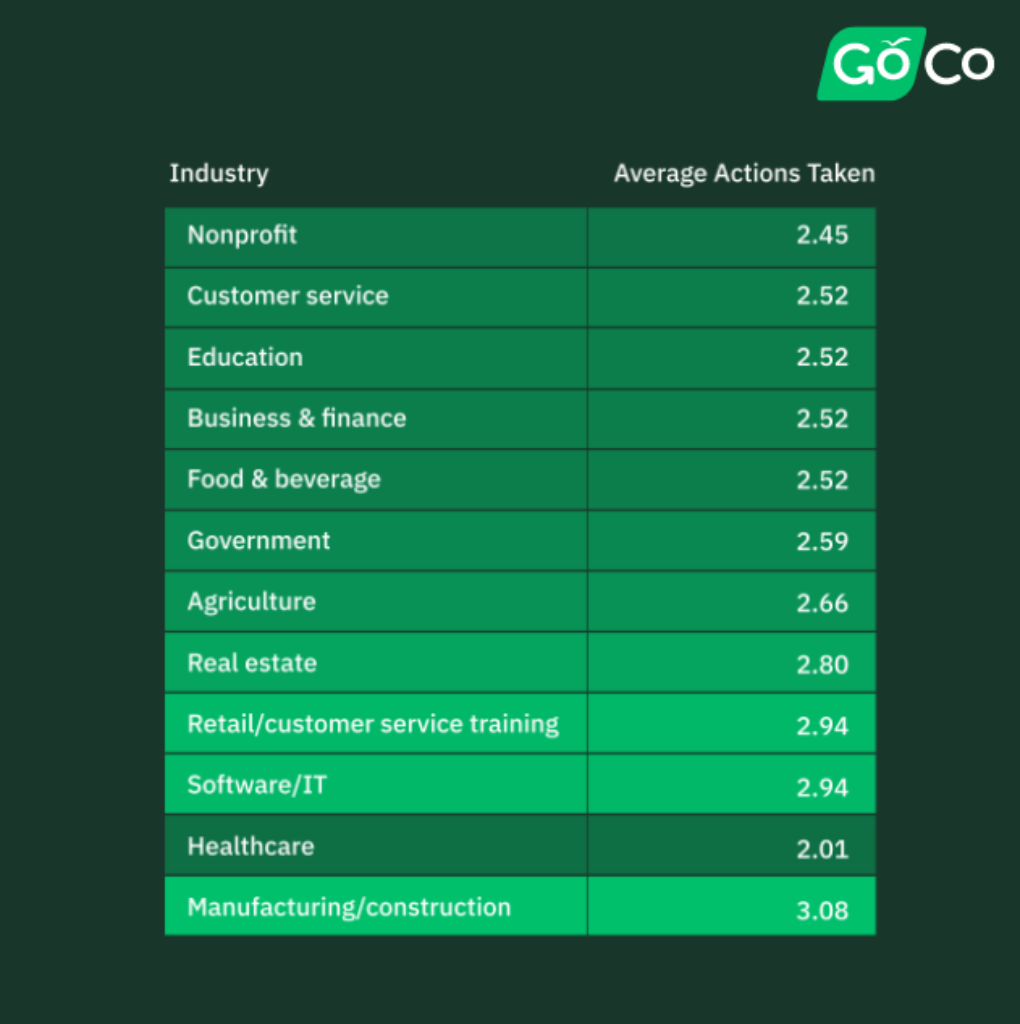
Conclusion
As the report from AlertMedia shared, health and safety are more important than ever to employees. Our report shows that HR professionals are stepping up and largely handling safety in the workplace. Many of the HR professionals we surveyed would be even more involved if they could.
We also see that there is still room for improvement. HR professionals have made a lot of progress to feel prepared, but there are still gaps across employee size, industry, and work location.
Ultimately, COVID has made HR professionals consider workplace health and safety, but employee health/illness isn't the only safety issue. Therefore, we must look beyond COVID to keep employees safe from threads, new or old.
Recommended Posts
77 Critical HR Statistics For 2023
Blog Articles
Search...
Product
GoCo
Resources
Articles
eBooks
Webinars
Customer Stories



